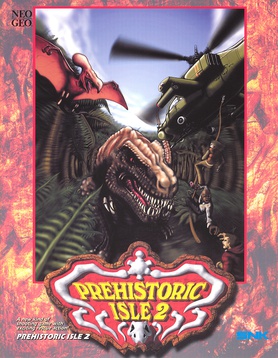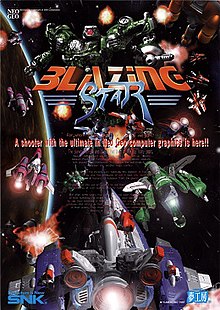
SNK Corporation is a Japanese video game hardware and software company. It is the successor to the company Shin Nihon Kikaku and presently owns the SNK video game brand and the Neo Geo video game platform, and electronics. SNK's predecessor Shin Nihon Kikaku Corporation was founded in 1978 by Eikichi Kawasaki. In 1981, the name was informally shortened to SNK Corporation, which became the company's official name in 1986.

Metal Slug is a 1996 run and gun arcade video game originally developed by Nazca Corporation and released by SNK for the Neo Geo MVS. It is the first installment in the eponymous series. Set in 2028, players assume the role of Peregrine Falcon Strike Force soldiers Marco Rossi and Tarma Roving on a fight against the Rebel Army led by Donald Morden and overthrow his coup d'état to prevent a New World Order.

Twinkle Star Sprites is a competitive vertically scrolling shooter arcade video game created by ADK and published by SNK in 1996. It was ADK's last production for the Neo Geo. Two players are each in separate, side-by-side, vertically scrolling levels. Combinations of shots and timed power-ups damage the other player. These attacks also serve as counters to the opponent's attack.

The King of Fighters '99: Millennium Battle is a 1999 fighting game developed and published by SNK for the Neo Geo MVS arcade and home consoles in 1999. It is the sixth installment in The King of Fighters series, introducing a new story arc known as the "NESTS Chronicles" which is centered around a young man named K', who is formerly associated with a mysterious yet threatening organization known only as NESTS. The game introduces several changes to the established KOF format, most notably an assisting character labeled "Striker". The game was ported to the Neo Geo CD and the PlayStation. Dreamcast and Microsoft Windows versions were also released under the title The King of Fighters' 99: Evolution whose stages were remodeled in 3D.

Aero Fighters 2 is a vertical-scrolling shoot 'em up arcade game released in 1994 by Video System. It is developed by SNK and released in Japan, North America and Europe. It is the second part of the Aero Fighters series followed by the third part Aero Fighters 3 and a spin-off Aero Fighters Assault. It was initially released as a cabinet token base game.

Alpha Mission II is a vertically scrolling full screen shoot 'em up released by SNK in 1991 for the Neo Geo arcade and home systems. It is the sequel to the 1985 arcade game Alpha Mission. It was later released for the Neo Geo CD in 1994 and for the PlayStation Portable in 2010.

Pulstar is a horizontally scrolling shooter released for arcades by SNK in 1995. Players control a starship in its mission to eradicate the Solar System of a hostile race of aliens that threaten mankind. Its gameplay has been compared to the R-Type series for its similar premise and mechanics; players must complete each of the game's eight stages by destroying constantly-moving formations of enemies and avoiding their projectiles. There are power-ups that can be collected that provide additional abilities for the player. It runs on the Neo Geo MVS arcade system board.

Aicom was a Japanese video game developer, founded in 1988. The Sammy Corporation website gives 1990 as its first year and says it was a subsidiary of Jaleco. Sammy bought it in 1992.

Ninja Master's: Haō Ninpō Chō,, is a ninja-themed 2D fighting game produced by ADK and originally released in 1996 for the Neo Geo arcade and home platform. Ninja Master's was the sixth and final fighting game produced by ADK, following the four games in the World Heroes series and Aggressors of Dark Kombat. It was later featured in the 2008 compilation ADK Damashii for the PlayStation 2. Ninja Master's was also re-released on the Neo-Geo X handheld system in 2012, and for the Virtual Console in 2013. In 2019 it was released as part of Arcade Archives developed by Japanese company Hamster. As of 2021, Ninja Master's was released worldwide on Nintendo Switch and Xbox One. The PS4 version remains exclusive to Asia but includes both Japanese and English releases.

Last Resort is a horizontally scrolling shooter by SNK released as an arcade video game in 1992. It was also released for the Neo-Geo and Neo Geo CD systems, SNK Arcade Classics Vol. 1 for the PlayStation 2, PlayStation Portable, and Wii, as well as ACA Neo-Geo for the PlayStation 4 and Xbox One.

Burning Fight is a beat 'em up arcade game released by SNK in 1991 for the Neo Geo MVS system. Introduced to capture a share in the then-popular beat 'em ups market, it was meant to compete with Technōs' Double Dragon, the leader of the genre at the time. Three years after its release in the arcades and on the Neo Geo AES, it was released on Neo Geo CD as the only other home version.

Top Hunter: Roddy & Cathy is a side scrolling arcade beat 'em up platform game developed by SNK for the Neo Geo in 1994. It was also released on the Neo Geo CD, and the Wii Virtual Console. The game has been re-released as part of SNK Arcade Classics Vol. 1, on May 1, 2008, and in the ACA Neo Geo series on PlayStation 4 on January 10, 2018. Its development team consisted of former Irem staff members.

Ghost Pilots is a vertically scrolling shooter arcade video game released in 1991 by SNK. It has elements similar to Capcom's 194X series, but the player controls a seaplane.

Zed Blade is a horizontally scrolling shooter arcade video game developed by NMK and originally published by SNK on September 13, 1994. It is the only game created by NMK for the Neo Geo arcade platform. In a science fiction setting, players choose one of three characters to attempt to overthrow an army of enemies led by the on-board supercomputer at the automated Yggdrasil space station and seize full control of it once again.
Arcade Archives is a series of emulated arcade games from the late 1970s, 1980s, 1990s, and early 2000s for PlayStation 4, Xbox One, Microsoft Windows, and Nintendo Switch, published by Hamster Corporation. A sub-series called ACA Neo Geo is focused on rereleasing Neo Geo titles in their original arcade format, unlike many services with attempts to emulate the console versions.

Gururin is a puzzle arcade video game developed by Face, with the assistance of Minato Giken, and originally published by SNK on May 25, 1994. It was the first game to be created by Face for the Neo Geo platform and it was not released on the Neo Geo AES (home).

Dunk Star is an unreleased 1991 basketball arcade video game that was in development and planned to be published by Sammy for the arcade Neo Geo MVS and Neo Geo AES home console. Had it been launched before Street Slam, it would have become the first basketball title for the Neo Geo platforms.

Over Top is a racing arcade video game developed by ADK and originally published by SNK on April 26, 1996. It is the spiritual successor to Thrash Rally, which was released earlier in 1991 on Neo Geo platforms.

Prehistoric Isle 2 is a 1999 scrolling shooter arcade video game co-developed by Saurus and Yumekobo and published by SNK. It is the sequel to the original Prehistoric Isle, which was developed and released earlier in 1989 by SNK. In the game, players take control of helicopters to shoot at dinosaurs while rescuing people. Although first launched in arcades, the title has since been re-released through download services for various consoles. It received mixed reception since its initial arcade release and garnered less success than its predecessor.

Super Sidekicks is a 1992 soccer arcade video game developed and published by SNK. It is the first installment in the eponymous series and the second soccer game released for Neo Geo MVS, succeeding Soccer Brawl (1991). Featuring an arcade-style approach to soccer compared to other games released at the time, the title allows players to choose any of the available game modes with AI-controlled opponents or other human players with the team of their choosing. Its gameplay uses a simplified two-button configuration.



















